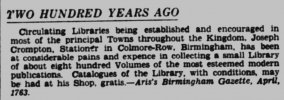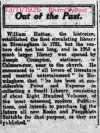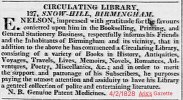In the 18C and 19C circulating libraries gave access to a range of books. A subscription fee, usually of several months to a year was charged. These early Libraries gave, mainly the middle classess, access to a range of reading material.
Some formed part of other retail interests such as newspapers and books, or could even be sold alongside completely unrelated items. Eventually, the fees changed to daily rates, enticing different customers and so moved towards a closer reflection of public demand. This expanded the collections of fiction available through the libraries.
Once circulation decreased, the books were sold. Circulating library customers were often female, and their patronage was actively sought, adding to their popularity. A few were located in millinery and stationery stores and midwives' offices. And some employed single women, widows, and retired women.
An early circulating library is this one was located at Joseph Crompton’s Stationers shop in Colmore Row. Source: British Newspaper Archive.
Viv.

Some formed part of other retail interests such as newspapers and books, or could even be sold alongside completely unrelated items. Eventually, the fees changed to daily rates, enticing different customers and so moved towards a closer reflection of public demand. This expanded the collections of fiction available through the libraries.
Once circulation decreased, the books were sold. Circulating library customers were often female, and their patronage was actively sought, adding to their popularity. A few were located in millinery and stationery stores and midwives' offices. And some employed single women, widows, and retired women.
An early circulating library is this one was located at Joseph Crompton’s Stationers shop in Colmore Row. Source: British Newspaper Archive.
Viv.

Last edited:


